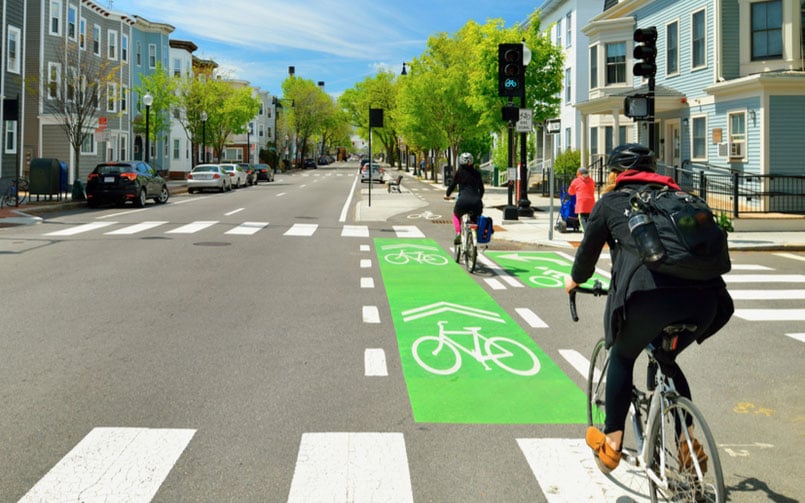The best bike lane width for protected bike lane design varies based upon the layout of the road, existing barriers, traffic levels, and so forth. Local regulations, traffic levels, and other factors may also influence how wide bike lanes should be in a particular area. Bike lanes are most beneficial on streets with high vehicle volume (greater than 3,000 vehicles on average per day), a speed limit that exceeds 25 mph, and areas that require better separation between bikes and automobiles.
There are three main classifications of bike lanes:
- Left-side bike lanes are positioned on the left side of one-way streets or two-way streets that are separated by a median.
- Buffered bike lanes include a buffer space between the bike lane and motor traffic.
- Cycle tracks are separate from roadways but still maintain the same on-street infrastructure seen with a traditional bike lane. They are often separated from main roadways through raised medians, on-street parking, or bollards.
An Overview of Bike Lane Width
Here is a breakdown of bike lane width requirements based on different designs and classifications.
For bike lanes that run adjacent to a curb, the ideal width is 6 feet. The ridable surface that runs adjacent to the street edge or longitudinal joint should be 4 feet, while the minimum width is 3 feet. If illegal parking is a common issue in your city, a 5-foot-wide bike lane is recommended.
For bike lanes with adjacent parking spots, the ideal length from the curb to the end of the bike lane (this includes the parking lane, bike lane, and a buffer of some sort) is 14.5 feet. Although, requirements set the limit at 12 feet. Bike lanes that run beside parking stalls must be 5 feet wide. If a marked buffer is provided between the bike lane and the parking stall, the width can be a little smaller. Experts on protected bike lane design recommend reducing parking spots in exchange for increased bike lane widths whenever possible.
If parking spots are used as a buffer between bike lanes and roadways, a 4-inch solid white line must mark the space between the parking lane and bike lane, thus limiting the chance vehicles enter the bike lane when parking.
For bike lanes that run beside a guardrail or other physical barrier, bike lanes must measure 2 feet wider than otherwise stated to provide adequate space for bikers to navigate beside barriers.
Bike Lane Width: Avoid Too Narrow & Too Wide
It is important to maintain the minimum required width for bike lanes to protect the safety of cyclists, pedestrians, and motorists. If space allows, adding some extra width can be beneficial and allow cyclists to more comfortably ride side-by-side. No matter what, bikers should be able to comfortably navigate without fear of weaving into traffic. Buffered bike lanes are ideal if there is adequate space. Adding a solid buffer or barrier between bikers and motorists is a great way to distinguish the bike path from traffic lanes, while keeping everyone safer. Plus, some barriers can add an aesthetic appeal, lighting elements, and so forth.
If a roadway has a lot of space it might be tempting to widen bike lanes far above the minimum requirements. Although, creating excessively wide bike lanes may present some issues. For instance, it tends to encourage illegal parking, especially in busy areas with limited parking. In addition, it often causes motor vehicles to use the bike lane perhaps to cut through traffic or simply out of confusion.
The Benefits of Adding Bike Lane Barriers
Physical barriers are optional, but solid white lines must be present to indicate the presence of a bike lane. In most jurisdictions, a 6 to 8-inch white line is used to mark the separation of motor vehicle lanes and bike lanes. Bike lane symbols and words or arrow markings must be included in the design so that both bikers and motorists can easily identify the bike lane.
Signs and street markings are a great start, but, if space allows, the addition of physical barriers offers added protection to bikers. Common physical barriers used to separate bike lanes from motor vehicle traffic include planters, bollards, parking spaces, and trees.
TerraCast Products offers a wide range of bike lane barriers, including bollards and heavy-duty planters. Shop our collection today!

